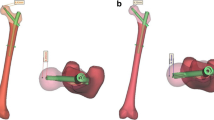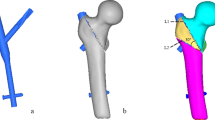Abstract
Background
This study evaluated the biomechanics of the proximal femoral nail antirotation-II (PFNA-II) in AO/OTA 31A2.2 intertrochanteric fractures based on the fracture reduction quality.
Methods
Unstable intertrochanteric fractures were created according to the AO classification and repaired by proximal femoral nail antirotation-II (PFNA-II) using one of three medial cortical support groups. The specimens were tested using cyclic axial loading. The following parameters were recorded: force and stiffness at failure, maximum vertical and horizontal displacement, neck-shaft angle, and location and patten of failure.
Results
In the cyclic loading test, the force at failure in the anatomical reduction (AR) group was greater than that of the positive medial cortical support (PMCS) group (984.22 ± 12.63 vs. 936.95 ± 16.78) N (P < 0.05) and negative medial cortical support (NMCS) group (918.04 ± 28.86) N (P < 0.05). The stiffness in the AR group was 4.77 and 31.9% higher than that in the PMCS group (P > 0.05) and NMCS group (P < 0.05). The maximum vertical displacement was the largest in the NMCS group. The maximum horizontal displacement in the NMCS group was 28.6 and 19.1% larger than that in the AR group (P > 0.05) and PMCS group (P < 0.05). The neck-shaft angle in the NMCS group was smaller than that in the anatomic reduction group (P < 0.05) and positive support group (P < 0.05).
Conclusion
For the unstable AO/OTA 31A2.2 intertrochanteric fracture, there were significant differences in their mechanical stability among AR, PMCS and NMCS. The NMCS is not recommended during the intraoperative reduction.





Similar content being viewed by others
References
Radaideh, A. M., Qudah, H. A., Audat, Z. A., Jahmani, R. A., Yousef, I. R., & Saleh, A. (2018). Functional and radiological results of proximal femoral nail antirotation (PFNA) osteosynthesis in the treatment of unstable pertrochanteric fractures. Journal of Clinical Medicine, 7(4), 78. https://doi.org/10.3390/jcm7040078
Füchtmeier, B., Gebhard, F., & Lenich, A. (2011). Komplikationen bei pertrochantären Frakturen [Complications after pertrochanteric fractures]. Der Unfallchirurg, 114(6), 479–484. https://doi.org/10.1007/s00113-011-1974-13
Uzoigwe, C. E., Burnand, H. G., Cheesman, C. L., Aghedo, D. O., Faizi, M., & Middleton, R. G. (2013). Early and ultra-early surgery in hip fracture patients improves survival. Injury, 44(6), 726–729. https://doi.org/10.1016/j.injury.2012.08.025
Kaufer, H. (1980). Mechanics of the treatment of hip injuries. Clinical Orthopaedics and Related Research, 146, 53–61.
Bretherton, C. P., & Parker, M. J. (2016). Femoral medialization, fixation failures, and functional outcome in trochanteric hip fractures treated with either a sliding hip screw or an intramedullary nail from within a randomized trial. Journal of Orthopaedic Trauma, 30(12), 642–646. https://doi.org/10.1097/BOT.0000000000000689
Weil, Y. A., Khoury, A., Zuaiter, I., Safran, O., Liebergall, M., & Mosheiff, R. (2012). Femoral neck shortening and varus collapse after navigated fixation of intracapsular femoral neck fractures. Journal of Orthopaedic Trauma, 26(1), 19–23. https://doi.org/10.1097/BOT.0b013e318214f321
Stern, L. C., Gorczyca, J. T., Kates, S., Ketz, J., Soles, G., & Humphrey, C. A. (2017). Radiographic review of helical blade versus lag screw fixation for cephalomedullary nailing of low-energy peritrochanteric femur fractures: There is a difference in cutout. Journal of Orthopaedic Trauma, 31(6), 305–310. https://doi.org/10.1097/BOT.0000000000000853
Carr, J. B. (2007). The anterior and medial reduction of intertrochanteric fractures: A simple method to obtain a stable reduction. Journal of Orthopaedic Trauma, 21(7), 485–489. https://doi.org/10.1097/BOT.0b013e31804797cf
Davis, T. R., Sher, J. L., Horsman, A., Simpson, M., Porter, B. B., & Checketts, R. G. (1990). Intertrochanteric femoral fractures. Mechanical failure after internal fixation. The Journal of Bone and Joint Surgery. British Volume, 72(1), 26–31. https://doi.org/10.1302/0301-620X.72B1.2298790
Biber, R., Berger, J., & Bail, H. J. (2016). The art of trochanteric fracture reduction. Injury, 47(Suppl 7), S3–S6. https://doi.org/10.1016/S0020-1383(16)30845-2
Baumgaertner, M. R., Curtin, S. L., Lindskog, D. M., & Keggi, J. M. (1995). The value of the tip-apex distance in predicting failure of fixation of peritrochanteric fractures of the hip. The Journal of Bone and Joint Surgery. American Volume, 77(7), 1058–1064. https://doi.org/10.2106/00004623-199507000-00012
Ozkan, K., Türkmen, İ, Sahin, A., Yildiz, Y., Erturk, S., & Soylemez, M. S. (2015). A biomechanical comparison of proximal femoral nails and locking proximal anatomic femoral plates in femoral fracture fixation: A study on synthetic bones. Indian journal of orthopaedics, 49(3), 347–351. https://doi.org/10.4103/0019-5413.156220
Ceynowa, M., Zerdzicki, K., Klosowski, P., Pankowski, R., Rocławski, M., & Mazurek, T. (2020). The early failure of the gamma nail and the dynamic hip screw in femurs with a wide medullary canal. A biomechanical study of intertrochanteric fractures. Clinical Biomechanics (Bristol, Avon), 71, 201–207. https://doi.org/10.1016/j.clinbiomech.2019.11.006
Cauley, J. A., Cawthon, P. M., Peters, K. E., Cummings, S. R., Ensrud, K. E., Bauer, D. C., Taylor, B. C., Shikany, J. M., Hoffman, A. R., Lane, N. E., Kado, D. M., Stefanick, M. L., Orwoll, E. S., & Osteoporotic Fractures in Men (MrOS) Study Research Group. (2016). Risk factors for hip fracture in older men: The osteoporotic fractures in men study (MrOS). Journal of Bone and Mineral Research: The Official Journal of the American Society for Bone and Mineral Research, 31(10), 1810–1819. https://doi.org/10.1002/jbmr.2836
Meinberg, E. G., Agel, J., Roberts, C. S., Karam, M. D., & Kellam, J. F. (2018). Fracture and dislocation classification compendium-2018. Journal of Orthopaedic Trauma, 32(Suppl 1), S1–S170. https://doi.org/10.1097/BOT.0000000000001063
Hsu, C. E., Shih, C. M., Wang, C. C., & Huang, K. C. (2013). Lateral femoral wall thickness. A reliable predictor of post-operative lateral wall fracture in intertrochanteric fractures. The Bone & Joint Journal, 95-B(8), 1134–1138. https://doi.org/10.1302/0301-620X.95B8.31495
Kaplan, K., Miyamoto, R., Levine, B. R., Egol, K. A., & Zuckerman, J. D. (2008). Surgical management of hip fractures: an evidence-based review of the literature. II: intertrochanteric fractures. The Journal of the American Academy of Orthopaedic Surgeons, 16(11), 665–673. https://doi.org/10.5435/00124635-200811000-00007
Anglen, J. O., & Weinstein, J. N. (2008). Nail or plate fixation of intertrochanteric hip fractures: changing pattern of practice. A review of the American Board of Orthopaedic Surgery Database. The Journal of Bone and Joint Surgery. American volume, 90(4), 700–707. https://doi.org/10.2106/JBJS.G.00517
Haidukewych, G. J., Israel, T. A., & Berry, D. J. (2001). Reverse obliquity fractures of the intertrochanteric region of the femur. The Journal of Bone and Joint Surgery. American Volume, 83(5), 643–650. https://doi.org/10.2106/00004623-200105000-00001
Rybicki, E. F., Simonen, F. A., & Weis, E. B., Jr. (1972). On the mathematical analysis of stress in the human femur. Journal of biomechanics, 5(2), 203–215. https://doi.org/10.1016/0021-9290(72)90056-5
Zdero, R., Walker, R., Waddell, J. P., & Schemitsch, E. H. (2008). Biomechanical evaluation of periprosthetic femoral fracture fixation. The Journal of Bone and Joint Surgery. American Volume, 90(5), 1068–1077. https://doi.org/10.2106/JBJS.F.01561
Kaiser, W., Burmester, J., Hausmann, H., Gulielmos, V., Hätzel, M., & Merker, H. J. (1997). Vergleichende Stabilitätsprüfungen von DHS- und gamma-Nagel-Osteosynthesen bei instabilen pertrochantären Femurosteotomien [Comparative stability evaluation of dynamic hip screw and gamma-nail osteosyntheses in unstable pertrochanteric femoral osteotomies]. Langenbecks Archiv fur Chirurgie, 382(2), 100–106. https://doi.org/10.1007/BF02465097
Kukla, C., Pichl, W., Prokesch, R., Jacyniak, W., Heinze, G., Gatterer, R., & Heinz, T. (2001). Femoral neck fracture after removal of the standard gamma interlocking nail: A cadaveric study to determine factors influencing the biomechanical properties of the proximal femur. Journal of Biomechanics, 34(12), 1519–1526. https://doi.org/10.1016/s0021-9290(01)00157-9
Aminian, A., Gao, F., Fedoriw, W. W., Zhang, L. Q., Kalainov, D. M., & Merk, B. R. (2007). Vertically oriented femoral neck fractures: Mechanical analysis of four fixation techniques. Journal of Orthopaedic Trauma, 21(8), 544–548. https://doi.org/10.1097/BOT.0b013e31814b822e
Kozono, N., Ikemura, S., Yamashita, A., Harada, T., Watanabe, T., & Shirasawa, K. (2014). Direct reduction may need to be considered to avoid postoperative subtype P in patients with an unstable trochanteric fracture: A retrospective study using a multivariate analysis. Archives of Orthopaedic and Trauma Surgery, 134(12), 1649–1654. https://doi.org/10.1007/s00402-014-2089-2
Tsukada, S., Okumura, G., & Matsueda, M. (2012). Postoperative stability on lateral radiographs in the surgical treatment of pertrochanteric hip fractures. Archives of Orthopaedic and Trauma Surgery, 132(6), 839–846. https://doi.org/10.1007/s00402-012-1484-9
Chang, S. M., Zhang, Y. Q., Ma, Z., Li, Q., Dargel, J., & Eysel, P. (2015). Fracture reduction with positive medial cortical support: A key element in stability reconstruction for the unstable pertrochanteric hip fractures. Archives of Orthopaedic and Trauma Surgery, 135(6), 811–818. https://doi.org/10.1007/s00402-015-2206-x
Gotfried, Y., Kovalenko, S., & Fuchs, D. (2013). Nonanatomical reduction of displaced subcapital femoral fractures (Gotfried reduction). Journal of Orthopaedic Trauma, 27(11), e254–e259. https://doi.org/10.1097/BOT.0b013e31828f8ffc
Funding
There is no funding to support this research.
Author information
Authors and Affiliations
Contributions
Conceptualization: LL, ZQ, KZ. Test and data statistics: ZQ. Writing—original draft: LL. Writing—review and editing: KZ.
Corresponding author
Ethics declarations
Conflict of Interest
The authors have no conflicts of interest to disclose. The authors alone are responsible for the content and writing of the paper. The datasets generated during and/or analyzed during the current study are available from the corresponding author on reasonable request.
Ethical Standard Statement
This article does not contain any studies with human or animal subjects performed by the any of the authors.
Informed Consent
For this type of study, informed consent is not required.
Additional information
Publisher's Note
Springer Nature remains neutral with regard to jurisdictional claims in published maps and institutional affiliations.
Rights and permissions
About this article
Cite this article
Ling, L., Qu, Z. & Zhou, K. Effect of Fracture Reduction with Different Medial Cortical Support on Stability After Cephalomedullary Nail Fixation of Unstable Pertrochanteric Fractures: A Biomechanical Analysis. JOIO 56, 34–40 (2022). https://doi.org/10.1007/s43465-021-00443-0
Received:
Accepted:
Published:
Issue Date:
DOI: https://doi.org/10.1007/s43465-021-00443-0




